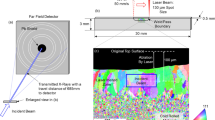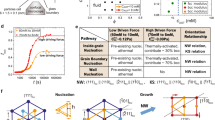Abstract
What determines the morphology of a decomposing alloy? Besides the well-established effect of the nucleation barrier, we demonstrate that, in a concentrated multicomponent Ni(Al,Cr) alloy, the details of the diffusion mechanism strongly affect the kinetic pathway of precipitation. Our argument is based on the combined use of atomic-scale observations, using three-dimensional atom-probe tomography (3D APT), lattice kinetic Monte Carlo simulations and the theory of diffusion. By an optimized choice of thermodynamic and kinetic parameters, we first reproduce the 3D APT observations, in particular the early-stage transient occurrence of coagulated precipitates. We then modify the kinetic correlations among the atomic fluxes in the simulation, without altering the thermodynamic driving force for phase separation, by changing the vacancy–solute interactions, resulting in a suppression of coagulation. Such changes can only be quantitatively accounted for with non-zero values for the off-diagonal terms of the Onsager matrix, at variance with classical models.
This is a preview of subscription content, access via your institution
Access options
Subscribe to this journal
Receive 12 print issues and online access
$259.00 per year
only $21.58 per issue
Buy this article
- Purchase on Springer Link
- Instant access to full article PDF
Prices may be subject to local taxes which are calculated during checkout





Similar content being viewed by others
References
Blavette, D. et al. The tomographic atom-probe—a quantitative 3-dimensional nanoanalytical instrument on an atomic-scale. Rev. Sci. Instrum. 64, 2911–2919 (1993).
Cerezo, A., Godfrey, T. J., Sijbrandij, S. J., Smith, G. D. W. & Warren, P. J. Performance of an energy-compensated three-dimensional atom probe. Rev. Sci. Instrum. 69, 49–58 (1998).
Kelly, T. F. et al. First data from a commercial local electrode atom probe (LEAP). Microsc. Microanal. 10, 373–383 (2004).
Soisson, F., Barbu, A. & Martin, G. Monte Carlo simulations of copper precipitation in dilute iron-copper alloys during thermal ageing and under electron irradiation. Acta Mater. 44, 3789–3800 (1996).
Pareige, C., Soisson, F., Martin, G. & Blavette, D. Ordering and phase separation in Ni-Cr-Al: Monte Carlo simulations versus three-dimensional atom probe. Acta Mater. 47, 1889–1899 (1999).
Sudbrack, C. K. et al. in Electron Microscopy: Its Role in Materials Research—The Mike Meshii Symposium (eds Weertman, J. R., Fine, M. E., Faber, K. T., King, W. & Liaw, P.) 43–50 (TMS; The Minerals, Metals & Materials Society, Warrendale, PA, 2003).
Sudbrack, C. K., Yoon, K. E., Noebe, R. D. & Seidman, D. N. Temporal evolution of the nanostructure and phase compositions in a model Ni–Al–Cr alloy. Acta Mater. 54, 3199–3210 (2006).
Sudbrack, C. K., Noebe, R. D. & Seidman, D. N. Compositional pathways and capillary effects during isothermal precipitation in a nondilute Ni–Al–Cr alloy. Acta Mater. 55, 119–130 (2007).
Clouet, E. et al. Complex precipitation pathways in multicomponent alloys. Nature Mater. 5, 482–488 (2006).
Allnatt, A. R. & Lidiard, A. B. Atomic Transport in Solids (Cambridge Univ. Press, Cambridge, 1993).
Andersson, J. & Ågren, J. Models for numerical treatment of multicomponent diffusion in simple phases. J. Appl. Phys. 72, 1350–1355 (1992).
Thornton, K., Ågren, J. & Voorhees, P. W. Modelling the evolution of phase boundaries in solids at the meso- and nano-scales. Acta Mater. 51, 5675–5710 (2003).
Binder, K. Applications of Monte Carlo methods to statistical physics. Rep. Prog. Phys. 60, 487–559 (1997).
Fratzl, P. & Penrose, O. Kinetics of spinodal decomposition in the Ising model with vacancy diffusion. Phys. Rev. B 50, 3477–3480 (1994).
Weinkamer, R. & Fratzl, P. By which mechanism does coarsening in phase separating alloys proceed? Europhys. Lett. 61, 261–267 (2003).
Martin, G. Atomic mobility in Cahn’s diffusion model. Phys. Rev. B 41, 2279–2283 (1990).
Athénes, M., Bellon, P. & Martin, G. Effects of atomic mobilities on phase separation kinetics: A Monte Carlo study. Acta Mater. 48, 3675–2688 (2000).
Le Bouar, Y. & Soisson, F. Kinetic pathways from EAM potentials: influence of the activation barriers. Phys. Rev. B 65, 094103 (2002).
Rautiainen, T. T. & Sutton, A. P. Influence of the atomic diffusion mechanism on morphologies, kinetics, and the mechanisms of coarsening during phase separation. Phys. Rev. B 59, 13681–13692 (1999).
Roussel, J. M. & Bellon, P. Vacancy-assisted phase separation with asymmetric atomic mobility: coarsening rates, precipitate composition, and morphology. Phys. Rev. B 63, 184114 (2001).
Hellman, O. C., Blatz du Rivage, J. & Seidman, D. N. Efficient sampling for three-dimensional atom probe microscopy data. Ultramicroscopy 95, 199–205 (2003).
Hellman, O. C., Vandenbroucke, J., Blatz du Rivage, J. & Seidman, D. N. Application software for data analysis for three-dimensional atom probe microscopy. Mater. Sci. Eng. A 327, 29–33 (2002).
Hellman, O. C., Vandenbroucke, J. A., Rüsing, J., Isheim, D. & Seidman, D. N. Analysis of three-dimensional atom-probe data by the proximity histogram. Microsc. Microanal. 6, 437–444 (2000).
Sudbrack, C. K. Decomposition Behavior in Model Ni-Al-Cr-X Superalloys: Temporal Evolution and Compositional Pathways on a Nanoscale. Thesis, Northwestern Univ. (2004) (http://arc.nucapt.northwestern.edu/refbase/show.php?record=16).
Yoon, K. E. Temporal Evolution of the Chemistry and Nanostructure of Multicomponent Model Ni-based Superalloys. Thesis, Northwestern Univ. (2004) (http://arc.nucapt.northwestern.edu/refbase/show.php?record=15).
Sudbrack, C. K., Noebe, R. D. & Seidman, D. N. Direct observations of nucleation in a nondilute multicomponent alloy. Phys. Rev. B 73, 212101 (2006).
Doyama, M. & Koehler, J. S. The relation between the formation energy of a vacancy and the nearest neighbor interactions in pure metals and liquid metals. Acta Metall. 24, 871–879 (1976).
Ardell, A. J. & Ozolins, V. Trans-interface diffusion-controlled coarsening. Nature Mater. 4, 309–316 (2005).
Lifshitz, I. M. & Slyozov, V. V. The kinetics of precipitation from supersaturated solid solutions. J. Phys. Chem. Solids 19, 35–50 (1961).
Wagner, C. Theorie der alterung von niederschlägen durch umlösen (Ostwald-reifung). Z. Elektrochem. 65, 581–591 (1961).
Martin, G. & Desgranges, C. Diffusion in crystals with nonconservative defects. Europhys. Lett. 44, 150–155 (1998).
Seidman, D. N. & Balluffi, R. W. in Lattice Defects and their Interactions (ed. Hasiguti, R. R.) 913–960 (Gordon-Breach, New York, 1968).
Svoboda, J., Fischer, F. D., Fratzl, P. & Kroupa, A. Diffusion in multi-component systems with no or dense sources and sinks for vacancies. Acta Mater. 50, 1369–1381 (2002).
Hartmann, A., Weinkamer, R., Fratzl, P., Svoboda, J. & Fischer, F. D. Onsager’s coefficients and diffusion laws—a Monte Carlo study. Phil. Mag. 85, 1243–1260 (2005).
Barbe, V. & Nastar, M. A self-consistent mean field calculation of the phenomenological coefficients in a multi-component alloy with high jump frequency ratios. Phil. Mag. 86, 1513–1538 (2006).
Foiles, S. M. & Adams, J. B. Thermodynamic properties of fcc transition metals as calculated with the embedded-atom method. Phys. Rev. B 40, 5909–5915 (1989).
Payne, M., Teter, R., Allan, D., Arias, T. & Joannopoulos, J. Iterative minimization techniques for ab initio total-energy calculations: molecular dynamics and conjugate gradients. Rev. Mod. Phys. 64, 1045–1097 (1992).
Chen, N., Chen, Z. & Wei, Y. Multidimensional inverse lattice problem and a uniformly sampled arithmetic Fourier transform. Phys. Rev. E 55, R5–R8 (1997).
Liu, S., Li, M. & Chen, N. Möbius transform and inversion from cohesion to elastic constant. J. Phys. Condens. Matter 5, 4381–4390 (1993).
Taylor, A. & Floyd, R. W. The constitution of nickel-rich alloys of the nickel-chromium-aluminum system. J. Inst. Met. 81, 451–464 (1952–53).
Acknowledgements
This research is supported by the National Science Foundation, Division of Materials Research, under contract DMR-0241928. C.K.S. received partial support from an NSF graduate research fellowship, a W. P. Murphy Fellowship and a Northwestern University terminal year fellowship. K.E.Y. received partial support from a NASA graduate fellowship. T. F. Kelly, Imago Scientific Instruments, is kindly thanked for the use of a LEAP tomograph before our acquisition of this instrument. The authors thank M. Asta, M. Athènes, P. Bellon, E. Clouet, M. Nastar and F. Soisson who interacted in many helpful discussions and S. M. Foiles for his grand canonical Monte Carlo code. G.M. was partially supported by an Eshbach Visiting Scholar Award from the McCormick School of Engineering and Applied Science at Northwestern University.
Author information
Authors and Affiliations
Contributions
Z.M. carried out the LKMC simulation; C.K.S. and K.E.Y. carried out the 3D APT experiments; D.N.S. supervised and mentored Z.M., C.K.S. and K.E.Y.; G.M. analysed the observations in terms of diffusion theory.
Corresponding author
Ethics declarations
Competing interests
The authors declare no competing financial interests.
Supplementary information
Supplementary Information
Supplementary figure S1 and table S1 (PDF 238 kb)
Rights and permissions
About this article
Cite this article
Mao, Z., Sudbrack, C., Yoon, K. et al. The mechanism of morphogenesis in a phase-separating concentrated multicomponent alloy. Nature Mater 6, 210–216 (2007). https://doi.org/10.1038/nmat1845
Received:
Accepted:
Published:
Issue Date:
DOI: https://doi.org/10.1038/nmat1845
This article is cited by
-
Experimental confirmation of high-temperature phase boundaries in the nickel-rich part of Ni-Al-Cr system
Archives of Civil and Mechanical Engineering (2022)
-
Phase-field simulation of element distribution and kinetics evolution of Cr/Cu core-shell nanoparticles in Fe–Cr–Al–Cu alloy
Applied Physics A (2022)
-
Evolution of γ′ precipitates in GH4742 superalloy based on complete forging-heat treatment process
Journal of Iron and Steel Research International (2022)
-
Temperature-Dependent Irradiation-Induced Clustering in a Fe–Mn–Ni Alloy
Metallurgical and Materials Transactions A (2021)
-
Current Challenges and Opportunities in Microstructure-Related Properties of Advanced High-Strength Steels
Metallurgical and Materials Transactions A (2020)



